![[Previous]](prev.gif) |
![[Contents]](contents.gif) |
![[Index]](keyword_index.gif) |
![[Next]](next.gif) |
![[Previous]](prev.gif) |
![[Contents]](contents.gif) |
![[Index]](keyword_index.gif) |
![[Next]](next.gif) |
In this chapter:
Code coverage is a way to measure how much code a particular process has executed during a test or benchmark. Using code-coverage analysis, you can then create additional test cases to increase coverage and determine a quantitative measure of code coverage, which is an indirect measure of the quality of your software (or better, a direct measure of the quality of your tests).
Several types of metrics are commonly used in commercial code-coverage tools, ranging from simple line or block coverage (i.e. “this statement was executed”) to condition-decision coverage (i.e. “all terms in this Boolean expression are exercised”). A given tool usually provides a combination of types.
The coverage tool in the IDE is a visual front end to the gcov metrics produced by the gcc compiler. These coverage metrics are essentially basic block coverage and branch coverage.
The IDE presents these metrics as line coverage, showing which lines are fully covered, partially covered, and not covered at all. The IDE also presents percentages of coverage in terms of the actual code covered (i.e. not just lines).
Block coverage, sometimes known as line coverage, describes whether a block of code, defined as not having any branch point within (i.e. the path of execution enters from the beginning and exits at the end) is executed or not.
By tracking the number of times the block of code has been executed, the IDE can determine the total coverage of a particular file or function. The tool also uses this information to show line coverage by analyzing the blocks on each line and determining the level of coverage of each.
Branch coverage can track the path of execution taken between blocks of code. Although this metric is produced by the gcc compiler, currently the IDE doesn't provide this information.
The IDE's code coverage tool works in conjunction with the compiler (gcc), the QNX C library (libc), and optionally the remote target agent (qconn). When code coverage is enabled for an application, the compiler instruments the code so that at run time, each branch execution to a basic block is counted. During the build, the IDE produces data files in order to recreate the program's flow graph and to provide line locations of each block.
 |
Since the IDE creates secondary data files at compilation
time, you must be careful when building your programs in a
multitargeted build environment, such as QNX Neutrino.
You must either:
Note also that the compiler's optimizations could produce unexpected results, so you should perform coverage tests on an unoptimized, debug-enabled build. |
When you build a program with the Build with Code Coverage build option enabled and then launch it using a C/C++ QNX Qconn (IP) launch configuration, the instrumented code linked into the process connects to qconn, allowing the coverage data to be read from the process's data space.
But if you launch a coverage-built process with coverage disabled in the launch configuration, this causes the process to write the coverage information to a data file (.gcda) at run time, rather than read it from the process's data space.
 |
You can later import the data into the IDE code coverage tool. For information about importing gcc coverage data from a project, see “Importing gcc code coverage data from a project” later in this chapter. |
Once a coverage session has begun, you can immediately view the data. The QNX Code Coverage perspective contains a Code Coverage Sessions view that lists previous as well as currently active sessions. You can explore each session and browse the corresponding source files that have received coverage data.
 |
Code Coverage might not work as expected because the code coverage data for C++ projects includes other functions that are also in the source file, such as static initializer and global constructor functions. In addition, the files included by include statements aren't included in the overall coverage total; only those functions that are in the original source are included for code coverage. |
To build executables with code coverage enabled:
 |
If more than one build variant is checked, the IDE displays an error message and disables the OK button. |
If you're using your own custom build environment, rather than QNX Makefiles, you'll have to manually pass the coverage option to the compiler.
To enable code coverage for non-QNX projects:
-fprofile-arcs -ftest-coverage
For example, your Makefile might look something like the Makefile below, which belongs to the Code Coverage example project included with the IDE (although, this example includes additional comments):
DEBUG = -g
CC = qcc
LD = qcc
CFLAGS += -Vgcc_ntox86 $(DEBUG) -c -Wc,-Wall -I. -O0 -Wc,-ftest-coverage -Wc,-fprofile-arcs
LDFLAGS+= -Vgcc_ntox86 $(DEBUG) -ftest-coverage -fprofile-arcs -p
# CC refers to the program for compiling C programs (the default is qcc. Use
# CXX as the program for compiling C++ programs.
# CFLAGS are additional flags to give to the C compiler. Use CFLAGS for the C++ compiler.
# -c compiles or assemble the source files, but doesn't link, and the -Wc captures
# the warning messages. The linking stage isn't done. The ultimate output is in the
form of an object file for each source file.
# -Wall turns on all optional warnings that are desirable for normal code.
# -I. adds the current directory to the list of directories to search for
# header files. Directories named by -I are searched before the standard system
# include directories.
# -O0 is an optimization flag that indicates 'Do not optimize.'
# LDFLAGS are additional flags to give to compilers when they invoke the ld linker.
# -ftest-coverage -Wc means that Code Coverage is enabled for your project,
# and the data is used for test coverage analysis.
# -fprofile-arcs adds code so that program flow arcs are instrumented. During
# execution, the program records how many times each branch and call is
# executed and how many times it is taken or returns, and it saves this
# data to a file with the extension .gcda for each source file.
# For Code Coverage, you'll need the -fprofile-arcs -ftest-coverage options in
# both the compile and link lines, as well as the -p option in the link line.
#
# -p is used to generate extra code to write profile information for the analysis
# program. You must use the -p option when compiling source files that you want
# data about, and you must also use it when linking.
dir := $(shell pwd)
BINS = rbt_client rbt_server
# This next line is the rule for <cmd>all</cmd> that incrementally builds your
# system by performing a <cmd>make</cmd> of all the top-level targets the
# Makefile knows about. It does this by expressing a dependency on the results
# of that system, which in turn have their own rules and dependencies.
all: $(BINS)
# The following line shows a simple rule for cleaning your build environment.
# It cleans your build environment by deleting all files that are normally
# created by running make.
# It has a Target named <cmd>clean</cmd> to left of the colon, no
# dependencies (to the right of the colon), and two commands that are indented
# by tabs on the lines that follow.
clean:
rm -f *.o *.img *.bb *.bbg *.gcno *.gcda $(BINS)
# The following lines are Dependency Rules, which are rules without any command.
# If any file to the right of the colon changes, the target to the left of the
# colon is no longer considered current (out of date).
# Dependency Rules are often used to capture header file dependencies.
rbt_server: rbt_server.o
# Alternatively, to manually capture dependencies, several automated
# dependency generators exist.
rbt_server.o : rbt_server.c rbt_server.h
$(CC) $(CFLAGS) $(dir)/$<
rbt_client: rbt_client.o
rbt_client.o: rbt_client.c rbt_server.h
$(CC) $(CFLAGS) $(dir)/$<
profileCPP-std: $(objects)
$(CC) -Vgcc_ntox86 $^ -g -p -o $@
-lcpp
 |
To enable Code Coverage for your project, you must use the options -fprofile-arcs -ftest-coverage when compiling and linking. For example, in the Makefile, you'll have the following gcc options set for Code Coverage: CFLAGS += -g -fprofile-arcs -ftest-coverage LDFLAGS+=-p -g -fprofile-arcs -ftest-coverage |
To start a program and measure the code coverage:
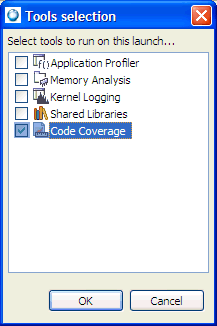
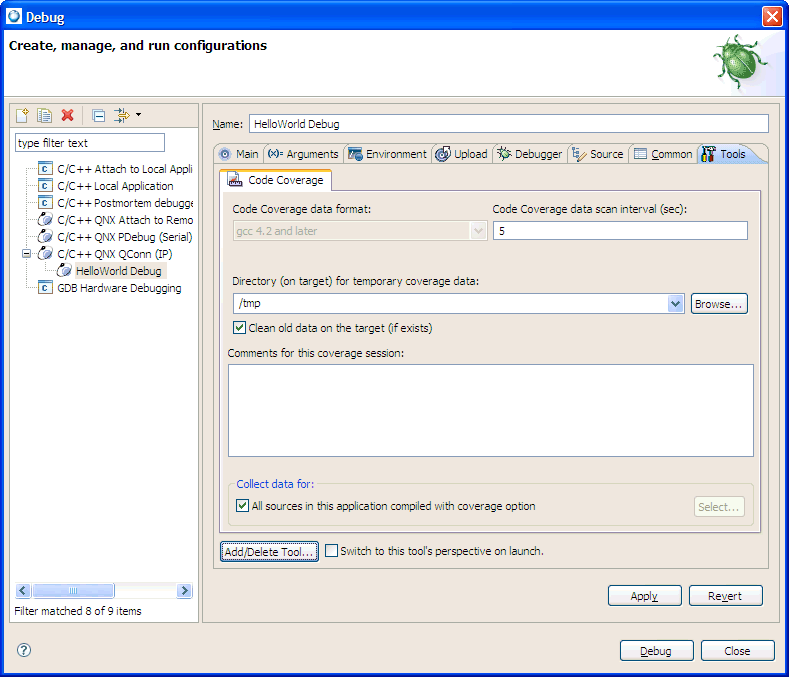
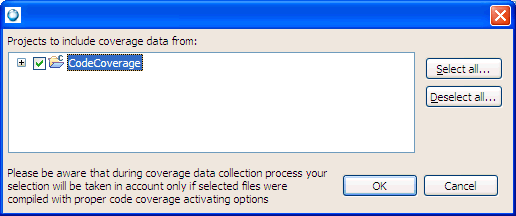
Previously, and for older compilers, if you launched a code coverage-enabled build process and chose to disable code coverage in the launch configuration, the process wrote the coverage information to a data file (.gcda) at run time, rather than read it from the process's data space. This meant that you could choose to import this data into the IDE Code Coverage tool at a later time. The newer gcc compiler doesn't stream the data coverage; the IDE waits for the generation of the data file before it copies it back to host machine.
In addition, the IDE generates notes files (.gcno) when it compiles projects that have enabled code coverage.
 |
There are multiple ways to import a file. It isn't necessary to move the file you want to import into the Workspace location. By default, the location of the .da files for the earlier versions of gcc 2.95.3 and 4.2 compilers that the IDE supported were located in /tmp (or another location, if specified). However, now the .gcda files are located in a folder structure created under the /tmp location. For the gcc 4.3 compiler, the .da files are also located in the same location under /tmp. If you buildt a project using an earlier version of gcc (version 2.95.3), the .bb and .bbg files were created in the same location where the source file was located. When copying a project_name.da file into your workspace, you must copy it to the top level of the directory structure. If you build the project using gcc version 4.3, the .bb and .bbg files are created under the variant_name/o_g directory. When copying the project_name.da file into your workspace, you must copy it to the same location where the .bb and .bbg files are located. In this case, it is the variant_name/o_g directory. |
To import gcc code coverage data from a project:
By default, you will not have the Target File System Navigator tab in your Tasks view. To add this tab to your view:
 |
If a previous project was built using gcc version 2.95, the .bb and .bbg files were created in the same location as the source file. Now, if a project is built using gcc version 4.3, .bb and .bbg files are created under variant_name/o_g directory. |
The project_name.da will be visible under the C/C++ tab for the corresponding project.
Now, you'll browse on the remote target to the folder that contains the data file.
Now, the Code Coverage tab shows the session name and imported gcc code coverage data for the selected project.
The QNX Code Coverage perspective includes the following views:
The Code Coverage Sessions view lets you control and display multiple code-coverage sessions:
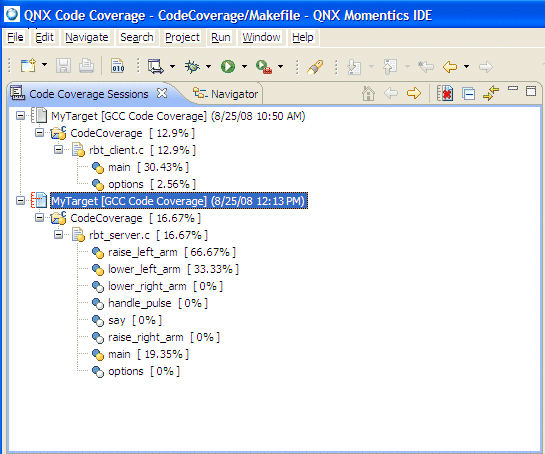
Viewing Code coverage sessions in the Code Coverage Sessions view.
The view shows the following as a hierarchical tree for each session:
| Session item | Description | Possible icons |
|---|---|---|
| Code coverage session | Launch configuration name, coverage tool, and start time (e.g. ccov102_factor [GCC Code Coverage] (7/2/03 2:48 PM)) | |
| Project | Project name and amount of coverage (e.g. ccov102_factor [ 86.67% ]) | |
| File | Filename and amount of coverage (e.g. ccov102_factor.c [ 86.67% ]) | |
| Function | Function name and amount of coverage (e.g. main [ 100% ]) |
The IDE uses several icons in this view:
| Icon | Icon Color | Meaning |
|---|---|---|
| White | No coverage | |
| Yellow | Partial coverage | |
| Green | Full (100%) coverage | |
| (cell is highlighted) | Out-of-date source file | |
| x | Red | An error marker to indicate some type of error (e.g. a code coverage data file was not found, or an error reading data or notes files). |
The IDE also adds a coverage markup icon (![]() ) to indicate source markup in the editor.
(See the “Examining data line-by-line” section, below.)
) to indicate source markup in the editor.
(See the “Examining data line-by-line” section, below.)
To reduce the size of
the hierarchical tree, you can click the Collapse All
(![]() ) button.
) button.
To combine several sessions:
The IDE can show the line-by-line coverage information
for your source code. In the left margin, the editor
shows you a “covered” icon (![]() ) beside
each line of source. In the right margin, the editor
shows a summary of the coverage by showing green sections for
fully-covered code, yellow for partial coverage, and red for no coverage.
) beside
each line of source. In the right margin, the editor
shows a summary of the coverage by showing green sections for
fully-covered code, yellow for partial coverage, and red for no coverage.
Code coverage markers are added to the left pane of the opened file.
To automatically show coverage information when opening a file:
The Properties view shows a summary of the code coverage for a project, file, or function you've selected in the Code Coverage Sessions view.
The Properties view tells you how many lines were covered, not covered, and so on:
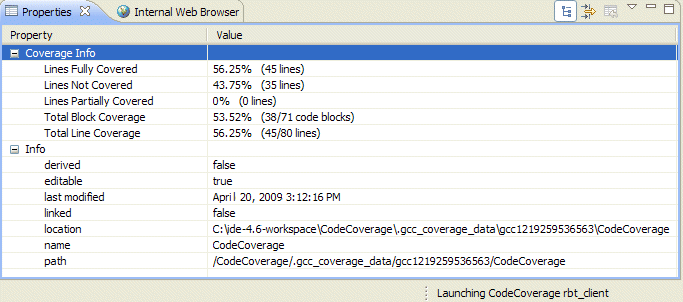
The Properties view showing the summary of the code coverage results for a selected project.
The Code Coverage Report view provides a summary (in XML) of your session. The view lets you “drill down” into your project and see the coverage for individual files and functions:
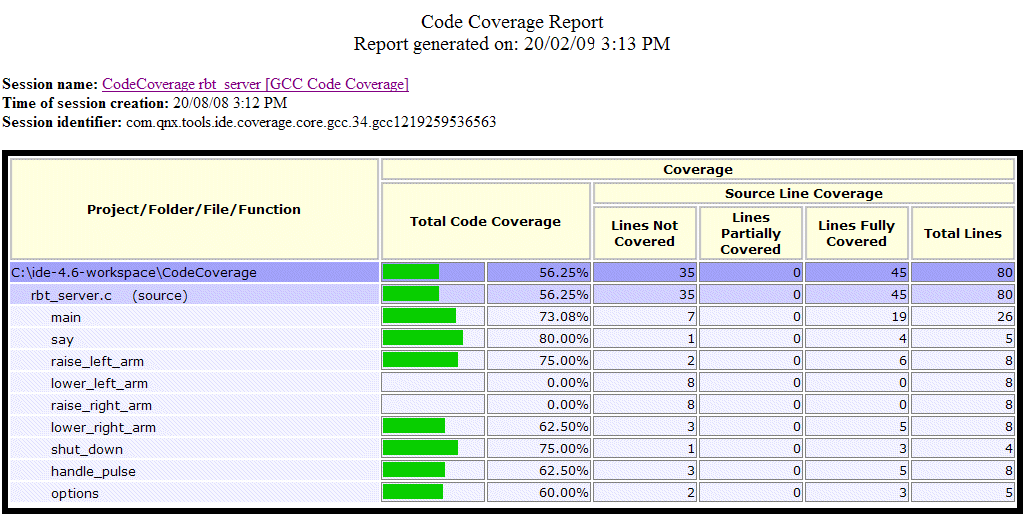
Code Coverage Report view summary.
To generate a report, simply right-click a coverage session and select Generate Report.
By default, the IDE shows reports in the Code Coverage Report view, but you can also have the IDE show reports in an external browser. Using an external browser lets you compare several reports simultaneously.
To toggle between viewing reports in the Code Coverage Report view and in an external browser:
To save a report:
By default, the report generated by the IDE doesn't include the code coverage information from other included files; however, you can choose to view this information, if desired.
![[Previous]](prev.gif) |
![[Contents]](contents.gif) |
![[Index]](keyword_index.gif) |
![[Next]](next.gif) |